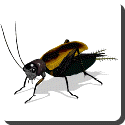 Cricket — Crickets, family Gryllidae (also known as “true crickets”), are insects somewhat related to grasshoppers and more closely related to katydids or bush crickets (family Tettigoniidae). They have somewhat flattened bodies and long antennae. There are about 900 species of crickets. They tend to be nocturnal and are often confused with grasshoppers because they have a similar body structure including jumping hind legs.
Cricket — Crickets, family Gryllidae (also known as “true crickets”), are insects somewhat related to grasshoppers and more closely related to katydids or bush crickets (family Tettigoniidae). They have somewhat flattened bodies and long antennae. There are about 900 species of crickets. They tend to be nocturnal and are often confused with grasshoppers because they have a similar body structure including jumping hind legs.
Crickets are known for their chirp (which only male crickets can do; male wings have ridges or “teeth” that act like a “comb and file” instrument). The left forewing has a thick rib (a modified vein) which bears 50 to 300 “teeth”. The chirp is generated by raising their left forewing to a 45 degree angle and rubbing it against the upper hind edge of the right forewing, which has a thick scraper (Berenbaum 1995). This sound producing action is called “stridulation” and the song is species-specific. There are two types of cricket songs: a calling song and a courting song. The calling song attracts females and repels other males, and is fairly loud. The courting song is used when a female cricket is near, and is a very quiet song.
Crickets chirp at different rates depending on their species and the temperature of their environment. Most species chirp at higher rates the higher the temperature is (approx. 60 chirps a minute at 13°C in one common species; each species has its own rate). The relationship between temperature and the rate of chirping is known as Dolbear’s Law. In fact, according to this law, it is possible to calculate the temperature in Fahrenheit by adding 40 to the number of chirps produced in 15 seconds by the snowy tree cricket common in the United States.
To hear the mating call of other crickets, a cricket has ears located on its knees, just below the joint of the front legs.
In 1970, Dr. William H. Cade discovered that the parasitic tachinid fly Ormia ochracea is attracted to the song of the male cricket, and uses it to locate the male in order to deposit her larvae on him. It was the first example of a natural enemy that locates its host or prey using the mating signal. Since then, many species of crickets have been found to be carrying the same parasitic fly, or related species.
Crickets are popular pets and are considered good luck in Asia, especially China where they are kept in cages (Carrera 1991). It is also common to have them as caged pets in some European countries, particularly in the Iberian Peninsula. Cricket fighting as a gambling or sports betting pastime also occurs, particularly in Macao. Crickets may also be eaten in some cultures, and are popular as live food for carnivorous pets.
The folklore and mythology surrounding crickets is extensive.
The singing of crickets in the folklore of Brazil and elsewhere is sometimes taken to be a sign of impending rain, or of a financial windfall. In Brazilian history, the sudden chirping of a cricket heralded the sighting of land for the crew of captain Álvar Núñez Cabeza de Vaca, just as their water supply had run out. (Lenko and Papavero 1996). In Caraguatatuba, Brazil, a black cricket in a room is said to portend illness; a gray one, money; and a green one, hope (Lenko and Papavero 1996). In Alagoas state, northeast Brazil, a cricket announces death, thus it is killed if it chirps in a house (Araújo 1977). In the village of Capueiruçu, Bahia State, a constantly chirping cricket foretells pregnancy, but if it pauses, money is expected (K.L.G. Lima, unpublished data). The mole cricket locally known as “paquinha”, “jeguinho”, “cachorrinho-d‘água”, or “cava-chão” (genera Scapteriscus and Neocurtilla, Gryllotalpidae) is said to predict rain when it digs into the ground (Fowler 1994).
In Barbados, a loud cricket means money is coming in; hence, a cricket must not be killed or evicted if it chirps inside a house. However, another type of cricket that is less noisy forebodes illness or death. (Forde 1988) In Zambia, the Gryllotalpa africanus cricket is held to bring good fortune to anyone who sees it (Mbata 1999).
In English-speaking comedy, the sound of crickets may be used to humorously indicate a dead silence when a response or activity is expected. For example, if a comedian in a TV show tells a bad joke, instead of the audience laughing, crickets may chirp.
The Disney corporation has used a number of notable cricket characters in their animated movies through the ages. Most of these characters represent good. For example, in the movie Pinocchio, Jiminy Cricket is honored with the position of the title character’s conscience. In Mulan, Cri-kee is carried in a cage as a symbol of luck, as in many Asian countries.
Crickets are omnivores and scavengers feeding on organic materials, as well as decaying plant material, fungi, and some seedling plants. Crickets also have been known to eat their own dead when there is no other source of food available.
Crickets mate in late summer and lay their eggs in the fall. The eggs hatch in the spring and they usually hatch in groups of 2,000. Female crickets have a long needle like egg-laying organ (ovipositor).
 Kids Portal For Parents India Kids Network
Kids Portal For Parents India Kids Network
